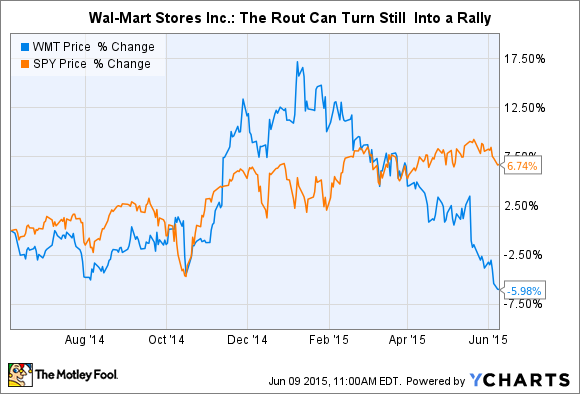
by Adam Hartung | Oct 16, 2015 | Current Affairs, Defend & Extend, In the Swamp, Lifecycle
Wal-Mart market value took a huge drop on Wednesday. In fact, the worst valuation decline in its history. That decline continued on Thursday. Since the beginning of 2015 Wal-Mart has lost 1/3 of its value. That is an enormous ouch.
 But, if you were surprised, you should not have been. The telltale signs that this was going to happen have been there for years. Like most stock market moves, this one just happened really fast. The “herd behavior” of investors means that most people don’t move until some event happens, and then everyone moves at once carrying out the implications of a sea change in thinking about a company’s future.
But, if you were surprised, you should not have been. The telltale signs that this was going to happen have been there for years. Like most stock market moves, this one just happened really fast. The “herd behavior” of investors means that most people don’t move until some event happens, and then everyone moves at once carrying out the implications of a sea change in thinking about a company’s future.
All the way back in October, 2010 I wrote about “The Wal-Mart Disease.” This is the disease of constantly focusing on improving your “core” business, while market shifts around you increasingly make that “core” less relevant, and less valuable. In the case of Wal-Mart I pointed out that an absolute maniacal focus on retail stores and low-cost operations, in an effort to be the low price retailer, was being made obsolete by on-line retailers who had costs that are a fraction of Wal-Mart’s expensive real estate and armies of employees.
At that time WMT was about $54/share. I recommended nobody own the stock.
In May, 2011 I reiterated this problem at Wal-Mart in a column that paralleled the retailer with software giant Microsoft, and pointed out that because of financial machinations not all earnings are equal. I continued to say that this disease would cripple Wal-Mart. Six months had passed, and the stock was about $55.
By February, 2012 I pointed out that the big reorganization at Wal-Mart was akin to re-arranging deck chairs on a sinking ship and said nobody should own the stock. It was up, however, trading at $61.
At the end of April, 2012 the Wal-Mart Mexican bribery scandal made the press, and I warned investors that this was a telltale sign of a company scrambling to make its numbers – and pushing the ethical (if not legal) envelope in trying to defend and extend its worn out success formula. The stock was $59.
Then in July, 2014 a lawsuit was filed after an overworked Wal-Mart truck driver ran into a car killing James McNair and seriously injuring comedian Tracy Morgan. Again, I pointed out that this was a telltale sign of an organization stretching to try and make money out of a business model that was losing its ability to sustain profits. Market shifts were making it ever harder to keep up with emerging on-line competitors, and accidents like this were visible cracks in the business model. But the stock was now $77. Most investors focused on short-term numbers rather than the telltale signs of distress.
In January, 2015 I pointed out that retail sales were actually down 1% for December, 2014. But Amazon.com had grown considerably. The telltale indication of a rotting traditional retail brick-and-mortar approach was showing itself clearly. Wal-Mart was hitting all time highs of around $87, but I reiterated my recommendation that investors escape the stock.
By July, 2015 we learned that the market cap of Amazon now exceeded that of Wal-Mart. Traditional retail struggles were apparent on several fronts, while on-line growth remained strong. Bigger was not better in the case of Wal-Mart vs. Amazon, because bigger blinded Wal-Mart to the absolute necessity for changing its business model. The stock had fallen back to $72.
Now Wal-Mart is back to $60/share. Where it was in January, 2012 and only 10% higher than when I first said to avoid the stock in 2010. Five years up, then down the roller coaster.
From October of 2010 through January, 2015 I looked dead wrong on Wal-Mart. And the folks who commented on my columns here at this journal and on my web site, or emailed me, were profuse in pointing out that my warnings seemed misguided. Wal-Mart was huge, it was strong and it would dominate was the feedback.
But I kept reiterating the point that long-term investors must look beyond short-term reported sales and earnings. Those numbers are subject to considerable manipulation by management. Further, short-term operating actions, like shorter hours, lower pay, reduced benefits, layoffs and gouging suppliers can all prop up short-term financials at the expense of recognizing the devaluation of the company’s long-term strategy.
Investors buy and hold. They hold until they see telltale signs of a company not adjusting to market shifts. Short-term traders will say you could have bought in 2010, or 2012, and held into 2014, and then jumped out and made a profit. But, who really can do that with forethought? Market timing is a fools game. The herd will always stay too long, then run out too late. Timers get trampled in the stampede more often than book gains.
In this week’s announcement Wal-Mart executives provided more telltale signs of their problems, and the fact that they don’t know how to fix them, and therefore won’t.
- Wal-Mart is going to spend $20B to buy back stock in order to prop up the price. This is the most obvious sign of a company that doesn’t know how to keep up its valuation by growing profits.
- Wal-Mart will spend $11B on sprucing up and opening stores. Really. The demand for retail space has been declining at 4-6%/year for a decade, and retail business growth is all on-line, yet Wal-Mart is still massively investing in its old “core” business.
- Wal-Mart will spend $1.1B on e-commerce. That is the proverbial “drop in the competitors bucket.” Amazon.com alone spent $8.9B in 2014 growing its on-line business.
- Wal-Mart admits profits will decline in the next year. It is planning for a growth stall. Yet, we know that statistically only 7% of companies that have a growth stall ever go on to maintain a consistent growth rate of a mere 2%. In other words, Wal-Mart is projecting the classic “hockey stick” forecast. And investors are to believe it?
The telltale signs of an obsolete business model have been present at Wal-Mart for years, and continue.
In 2003 Sears Holdings was $25/share. In 2004 Sears bought K-Mart, and the stock was $40. I said don’t go near it, as all the signs were bad and the merger was ill-conceived. Despite revenue declines, consistent losses, a revolving door at the executive offices and no sign of any plan to transform the battered, outdated retail giant against growing on-line competition investors believed in CEO Ed Lampert and bid the stock up to $77 in early 2011. (I consistently pointed out the telltale signs of trouble and recommended selling the stock.)
By the end of 2012 it was clear Sears was irrelevant to holiday shoppers, and the stock was trading again at $40. Now, SHLD is $25 – where it was 12 years ago when Mr. Lampert started his machinations. Again, only a market timer could have made money in this company. For long-term investors, the signs were all there that this was not a place to put your money if you want to have capital growth for retirement.
There will be plenty who will call Wal-Mart a “value” stock and recommend investors “buy on weakness.” But Wal-Mart is no value. It is becoming obsolete, irrelevant – increasingly looking like Sears. The likelihood of Wal-Mart falling to $20 (where it was at the beginning of 1998 before it made an 18 month run to $50 more than doubling its value) is far higher than ever trading anywhere near its 2015 highs.
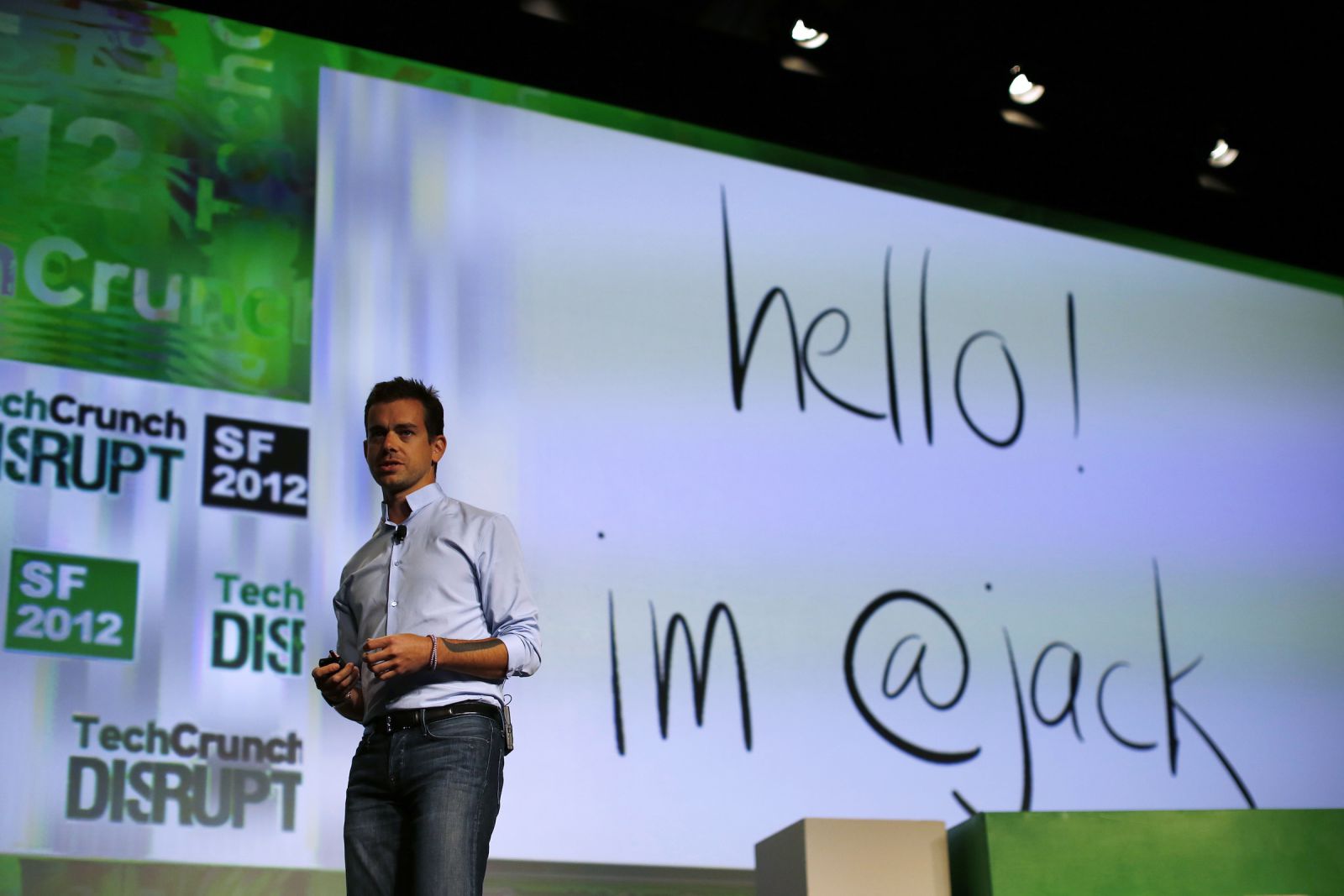
by Adam Hartung | Oct 5, 2015 | Current Affairs, In the Rapids, Innovation, Leadership, Web/Tech
Twitter’s Board decided in July to oust the CEO, Dick Costolo, due to frustration over company profits. As I wrote at the time, Twitter had continued to add members, at a rate comparable to its social media competition. And it had grown revenues, while remaining the industry leader in revenue per active user.
But the concern was a lack of profits. Oh my, if rapid revenue growth but weak profits were a reason to fire a CEO, how does Jeff Bezos keep his job?
 Anyway, Mr. Costolo was replaced by an original founder and former Twitter CEO Jack Dorsey on an interim basis. Four months later, after failing in its effort to find a suitable full-time CEO, the Board has made Mr. Dorsey the permanent CEO. While he simultaneously remains full time CEO of Square, a mobile payments processing company.
Anyway, Mr. Costolo was replaced by an original founder and former Twitter CEO Jack Dorsey on an interim basis. Four months later, after failing in its effort to find a suitable full-time CEO, the Board has made Mr. Dorsey the permanent CEO. While he simultaneously remains full time CEO of Square, a mobile payments processing company.
As I said in my last column on this subject, investors better beware.
Facebook is tearing up the social media market. It has grown to be not only #1 in active monthly users, but at 1.5B monthly active users (MSUs) the site has 5 times the number of users that Twitter has. By adding a slew of new features and functions Facebook has become more valuable to its users – and advertisers.
According to Statista, simultaneously Facebook has grown Facebook Messenger to 700M MSUs, acquired WhatsApp with 800M MSUs and Instagram with 400M MSUs. By constantly expanding the ecosphere Facebook now has 3.4B MSUs – over 10 times the number of Twitter. Facebook is so dominant that even muscular Google, with all its resources, abandoned its efforts to compete with the juggernaut by killing Google+ (which had 300M MSUs) earlier in 2015.
Twitter had great organic growth numbers, but unlike competitors it does not dominate any particular category of social media. Linked in, with only 100M MSUs dominates business networking, and bosts a user base that skews older and more professional. Pinterest and Instagram are battling it out for leadership in photo sharing. But it is unclear how one would describe a social growth category that Twitter dominates.
I actively use Twitter. But among my peers I am the exception. When I ask people over 40 if they use Twitter I regularly hear “I don’t get it. It all looks completely chaotic. Why would I want to follow people on Twitter, and why would I want to post.” This sounds a lot like what people said of Facebook and Linked in 5 years ago. But those companies found their connection with users and people now “get it.”
So the question is whether Mr. Dorsey will make Twitter into a site that is ubiquitous, at least for one category. Can he make the product so useful that users can’t live without it, and that continues drawing in massive new numbers of users?
Twitter has not changed much at all since it was founded. It still depends on users to sign on, start tweeting, and search out others a user wants to follow. And that means follow for some reason other than that person is a celebrity or politician that simply can’t stop spouting off. The Twitter user has to hunt for like minded individuals, find a way to connect with folks who are informative to their needs and then create a dialogue — and all with pretty much the same character limits and shrunken link technology available many years ago.
Apple floundered as a manufacturer of niche PCs. The returning CEO, Steve Jobs, resurrected the company by putting all his money on mobile. It wasn’t an improved Mac that turned around Apple, but rather the launch of the iPod and iTunes, followed by the iPhone and the iPad. The way Apple stole the thunder from previously dominant Microsoft was by creating new products built on the mobile trend that led to explosive growth.
Mr. Costolo left Twitter in far better shape than Apple was in when Mr. Jobs retook the reins. But will Mr. Dorsey be able to launch a series of new products that can create an Apple-like growth explosion?
Square, where Mr. Dorsey ostensibly spends half his time, is preparing to go public. But, even though it is currently considered by many the leader in its marketplace, Square is looking down the barrel of ApplePay – a technology on every iPhone that could make it obsolete. Then there’s also Google Wallet that is on all the other smartphones. Plus well funded outfits like PayPal and Mastercard. Square will need a very competent, capable and visionary CEO to guide its development competing with these – and other – well funded and powerful companies. Square will need to add features, functions and benefits if it is create long-term value.
A lot of new products are needed by two relatively small companies in short order if they are to survive. Success will not happen by cutting costs in either. It will require intensive product development with very rapid product cycles that bring in millions upon millions of new users.
Twitter was once a disruptive innovator. Now it is hard to recognize any innovation at Twitter. Does Mr. Dorsey get it? And if he does, can he do it? And do it twice, simultaneously?

by Adam Hartung | Sep 29, 2015 | Current Affairs, Leadership, Quotes
The stock market is incredibly fickle. In the short term, stock prices can swing significantly on such short-term news as:
- What are reviewers saying about the newest, yet-to-be released iPhone?
- Will Amazon use drones for shipping?
- How many people in Latin America signed up for Netflix?
You get the drift. But for long-term investors there is quite a bit more to creating long-term, sustainable shareholder value than short-term news. If you’re not a short-term trader, standing back and taking the long-term view is important for deciding where to invest your hard-earned savings.
The National Association of Corporate Directors (NACD) has over 17,000 members that serve on Boards of publicly traded, for-profit private and non-profit organizations. It is the world’s leading association studying regulations and how they are applied, and recommending best practices for Boards of Directors to apply corporate governance.
At their annual meeting this week NACD released its newest report The Board and Long-Term Value Creation created by its Blue Ribbon Commission of leading Directors. Succinctly, the report calls on all Boards to help management overcome myopia around short-term results, and increase attention on creating long-term value.
 Most metrics used in business are very short-term, including sales, volume, costs and margin. The report points out that at most companies long-term compensation is defined as 3 years or less — shorter than most new product development programs or even new branding or image creation programs. Unfortunately, this can lead to spending too much time on tactics and machinations to drive short-term reporting, hoping that the long-term will simply take care of itself.
Most metrics used in business are very short-term, including sales, volume, costs and margin. The report points out that at most companies long-term compensation is defined as 3 years or less — shorter than most new product development programs or even new branding or image creation programs. Unfortunately, this can lead to spending too much time on tactics and machinations to drive short-term reporting, hoping that the long-term will simply take care of itself.
“Instead of viewing short-term results and long-term strategy as mutually exclusive, boards and executives should view them in terms of degrees of alignment,” said Karen Horn, co-chair of the NACD Blue Ribbon Commission; vice chair of the NACD board; and director of Eli Lilly & Co., Norfolk Southern Corp., Simon Property Group, and T. Rowe Price Mutual Funds. “It should be possible to draw a clear line from the company’s day-to-day activities to its long-term objectives.”
“Board agendas need to accommodate sufficient time for substantive discussions about long-term opportunities and risks, rather than being dominated by backward-looking reviews of past performance,” said Bill McCracken, co-chair of the NACD Blue Ribbon Commission, former CEO of CA Technologies, and director of MDU Resources and NACD.
The report notes that short-term pressures on management are greater than ever. But Boards can take measures to bring the focus back on long-term value creation by actively engaging in various activities, such as:
-
developing long-term strategy,
-
reviewing capital allocation process and where money is invested,
-
careful consideration of management incentives including compensation,
-
applying oversight to corporate culture,
-
participating in communications with analysts, investors, and other constituencies.
“The Commission believes that directors need to be active students of the business, seeking out information from multiple sources in preparation for boardroom discussions rather than being passive recipients of data from management. And rather than being dominated by retrospective analysis of past performance, board agendas should provide adequate time for substantive discussion of long-term strategic choices, risks, and opportunities.”
From great minds come great reads. NACD membership is growing at double digit rates, at a time when many associations struggle to maintain membership. As regulations on officers and directors grow, NACD’s active development of programs and reports providing guidance to Directors on how they can meet ever increasing demands to provide effective, active governance is providing great value to those leading America’s organizations. This Blue Ribbon Commission report is another example of forward-thinking guidance that all corporate directors and officers (and investors) should read.
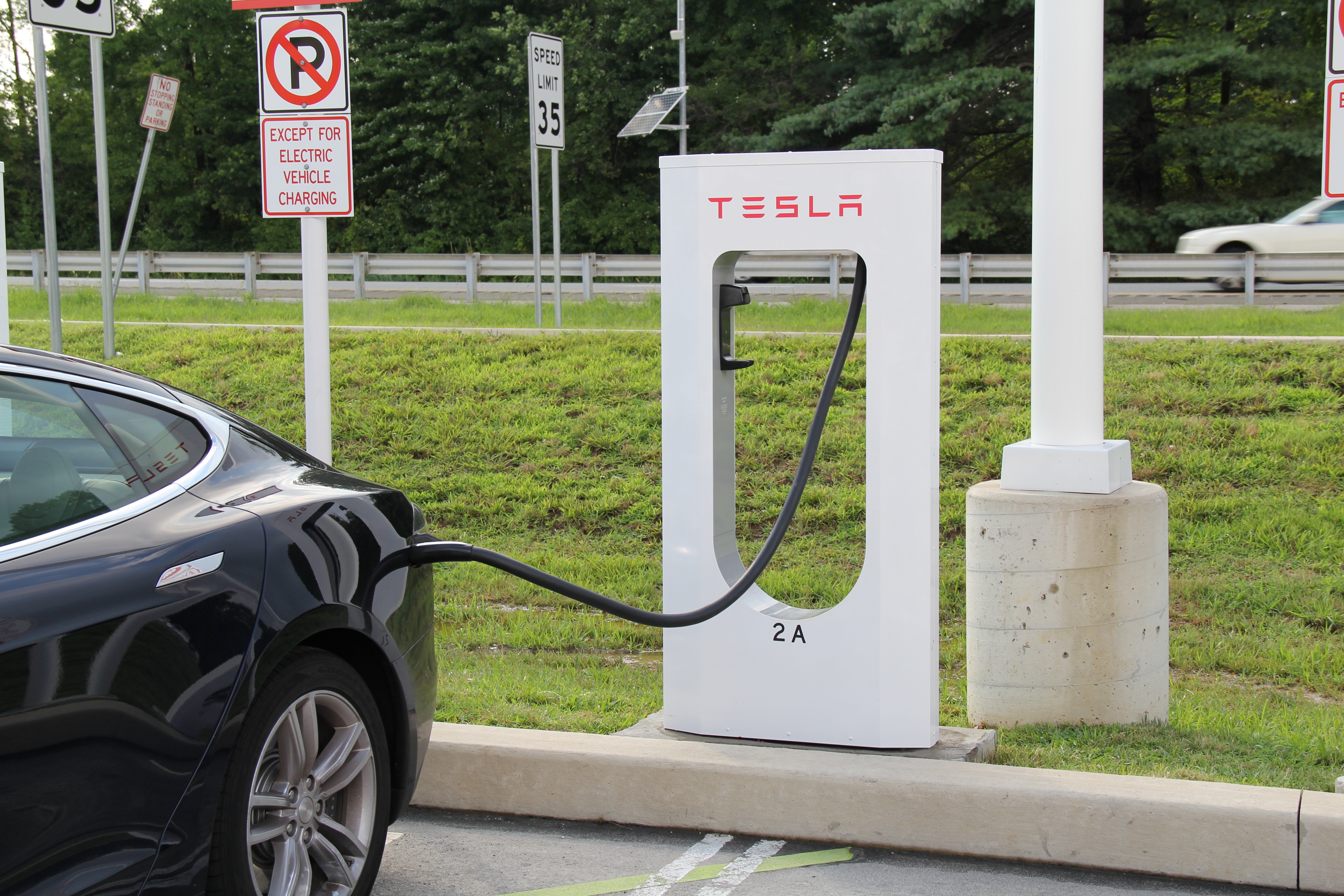
by Adam Hartung | Sep 22, 2015 | Current Affairs, Disruptions, In the Rapids, Innovation
A recent analyst took a look at the impact of electric vehicles (EVs) on the demand for oil, and concluded that they did not matter. In a market of 95million barrels per day production, electric cars made a difference of 25,000 to 70,000 barrels of lost consumption; ~.05%.
You can’t argue with his arithmetic. So far, they haven’t made any difference.
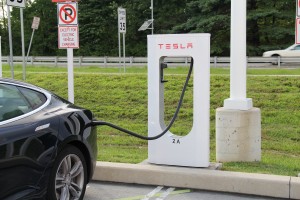 But then he goes on to say they won’t matter for another decade. He forecasts electric vehicle sales grow 5-fold in one decade, which sounds enormous. That is almost 20% growth year over year for 10 consecutive years. Admittedly, that sounds really, really big. Yet, at 1.5million units/year this would still be only 5% of cars sold, and thus still not a material impact on the demand for gasoline.
But then he goes on to say they won’t matter for another decade. He forecasts electric vehicle sales grow 5-fold in one decade, which sounds enormous. That is almost 20% growth year over year for 10 consecutive years. Admittedly, that sounds really, really big. Yet, at 1.5million units/year this would still be only 5% of cars sold, and thus still not a material impact on the demand for gasoline.
This sounds so logical. And one can’t argue with his arithmetic.
But one can argue with the key assumption, and that is the growth rate.
Do you remember owning a Walkman? Listening to compact discs? That was the most common way to listen to music about a decade ago. Now you use your phone, and nobody has a walkman.
Remember watching movies on DVDs? Remember going to Blockbuster, et.al. to rent a DVD? That was common just a decade ago. Now you likely have shelved the DVD player, lost track of your DVD collection and stream all your entertainment. Bluckbuster, infamously, went bankrupt.
Do you remember when you never left home without your laptop? That was the primary tool for digital connectivity just 6 years ago. Now almost everyone in the developed world (and coming close in the developing) carries a smartphone and/or tablet and the laptop sits idle. Sales for laptops have declined for 5 years, and a lot faster than all the computer experts predicted.
Markets that did not exist for mobile products 10 years ago are now huge. Way beyond anyone’s expectations. Apple alone has sold over 48million mobile devices in just 3 months (Q3 2015.) And replacing CDs, Apple’s iTunes was downloading 21million songs per day in 2013 (surely more by now) reaching about 2billion per quarter. Netflix now has over 65million subscribers. On average they stream 1.5hours of content/day – so about 1 feature length movie. In other words, 5.85billion streamed movies per quarter.
What has happened to old leaders as this happened? Sony hasn’t made money in 6 years. Motorola has almost disappeared. CD and DVD departments have disappeared from stores, bankrupting Circuit City and Blockbuster, and putting a world of hurt on survivors like Best Buy.
The point? When markets shift, they often shift a lot faster than anyone predicts. 20%/year growth is nothing. Growth can be 100% per quarter. And the winners benefit unbelievably well, while losers fall farther and faster than we imagine.
Tesla was barely an up-and-comer in 2012 when I said they would far outperform GM, Ford and Toyota. The famous Bob Lutz, a long-term widely heralded auto industry veteran chastised me in his own column “Tesla Beating Detroit – That’s Just Nonsense.”
Mr. Lutz said I was comparing a high-end restaurant to McDonald’s, Wendy’s and Pizza Hut, and I was foolish because the latter were much savvier and capable than the former. He should have used as his comparison Chipotle, which I predicted would be a huge winner in 2011. Those who followed my advice would have made more money owning Chipotle than any of the companies Mr. Lutz preferred.
The point? Market shifts are never predicted by incumbents, or those who watch history. The rate of change when it happens is so explosive it would appear impossible to achieve, and far more impossible to sustain. The trends shift, and one market is rapidly displaced by another.
While GM, Ford and Toyota struggle to maintain their mediocrity, Tesla is winning “best car” awards one after another – even “breaking” Consumer Reports review system by winning 103 points out of a maximum 100, the independent reviewer liked the car so much. Tesla keeps selling 100% of its production, even at its +$100K price point.
So could the market for EVs wildly grow? BMW has announced it will make all models available as electrics within 10 years, as it anticipates a wholesale market shift by consumers promoted by stricter environmental regulations. Petroleum powered car sales will take a nosedive.
The International Energy Agency (IEA) points out that EVs are just .08% of all cars today. And of the 665,000 on the road, almost 40% are in the USA, where they represent little more than a rounding error in market share. But there are smaller markets where EV sales have strong share, such as 12% in Norway and 5% in the Netherlands.
So what happens if Tesla’s new lower priced cars, and international expansion, creates a sea change like the iPod, iPhone and iPad? What happens if people can’t get enough of EVs? What happens if international markets take off, due to tougher regulations and higher petrol costs? What happens if people start thinking of electric cars as mainstream, and gasoline cars as old technology — like two-way radios, VCRs, DVD players, low-definition picture tube TVs, land line telephones, fax machines, etc?
What if demand for electric cars starts doubling each quarter, and grows to 35% or 50% of the market in 10 years? If so, what happens to Tesla? Apple was a nearly bankrupt, also ran, tiny market share company in 2000 before it made the world “i-crazy.” Now it is the most valuable publicly traded company in the world.
Already awash in the greatest oil inventory ever, crude prices are down about 60% in the last year. Oil companies have already laid-off 50,000 employees. More cuts are planned, and defaults expected to accelerate as oil companies declare bankruptcy.
It is not hard to imagine that if EVs really take off amidst a major market shift, oil companies will definitely see a precipitous decline in demand that happens much faster than anticipated.
To little Tesla, which sold only 1,500 cars in 2010 could very well be positioned to make an enormous difference in our lives, and dramatically change the fortunes of its shareholders — while throwing a world of hurt on a huge company like Exxon (which was the most valuable company in the world until Apple unseated it.)
[Note: I want to thank Andreas de Vries for inspiring this column and assisting its research. Andreas consults on Strategy Management in the Oil & Gas industry, and currently works for a major NOC in the Gulf.]
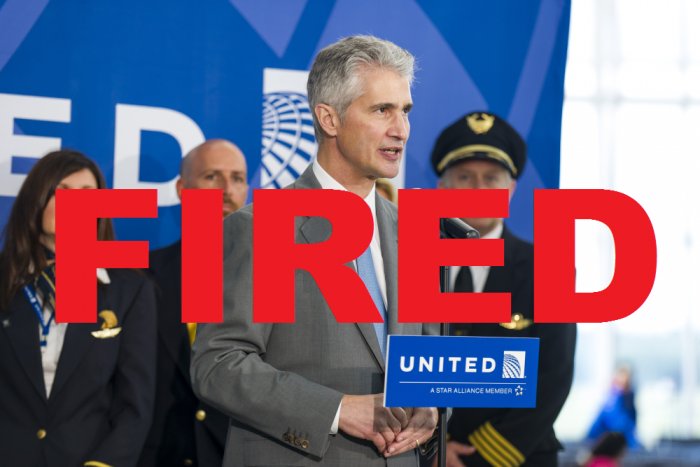
by Adam Hartung | Sep 11, 2015 | Current Affairs, Defend & Extend, In the Swamp, Leadership
Jeff Smisek, CEO of United Continental Holdings, was fired this week. It appears he was making deals with public officials (specifically the Chairman of the Port Authority of New York and New Jersey) to keep personally favored flights of politicians in the air, even when unprofitable, in a quid-pro-quo exchange for government subsidies to move a taxiway and better airport transit.
Wow, horse-trading of the kind that put the governor of Illinois in the penitentiary.
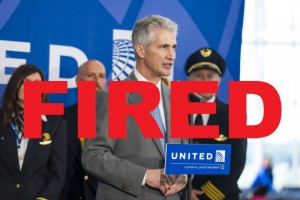 But you have to ask yourself, couldn’t you see it coming? Or are we just so used to lousy leadership that we think there’s no end to it?
But you have to ask yourself, couldn’t you see it coming? Or are we just so used to lousy leadership that we think there’s no end to it?
United has been beset with a number of problems. Since Mr. Smisek organized the merger of Continental (his former employer) with United, creating the world’s largest airline at the time, things have not gone well. Since announcing the merger in 2010, more has gone wrong than right at United:
The merged airline didn’t start in a great position. It was in 2009 that a budding musician watched United baggage handlers destroy his guitar, leading to a series of videos on bad customer service that took to the top of YouTube and iTunes and his book on the culture of customer abuse at United underscored a major PR nightmare.
How could things seem to constantly become worse? It was clear that at the top, United’s leadership cared only about cost control (ironically code named Project Quality.) Operational efficiency was seen as the only strategy, and it did not matter how much this strategy disaffected employees, suppliers or customers. In 2013 United ranked dead last in the quality ranking of all airlines by Wichita State University, and the airline replied by saying it really didn’t care.
The power of thinking that if you focus on pennies and nickels the quarters and dollars will take care of themselves is strong. It encourages you be very focused on details, even myopic, and operate your business very narrowly. And it can set you up to make really dumb mistakes, like possibly trading airline flights for construction subsidies.
Focus, focus, focus often leads to being blind, blind, blind to the world around you.
There were ample signs of all the things going wrong at United, and the need for a change. The open question is why it took a criminal investigation into bribing government officials for the airline’s Board to fire the CEO? Bad performance apparently didn’t matter? Do you have to be an accused lawbreaker to be shown the door?
The story broke in February, so the Board has had a few months to find a replacement CEO. Mr. Oscar Munoz will now take the reigns. But one has to wonder if he is up for the challenges. As a former railroad President, his world of relationships was much smaller than the millions of customers and 84,000 employees at United.
United’s top brass has a serious need “to get over itself.” United’s internal focus, driven by costs, has disenfranchised its brand embassadors, its customer base, and many industry analysts.
United needs to become a lot clearer about what customers really need and want. Years of overly simplistic “all customers care about is price” has commoditized United’s approach to air travel. Customers have been smart enough to see through lower seat prices, only to be stuck with seat assignment and baggage fees raising total trip cost. And charging for everything on the plane, including cheesy TV shows, has customers wondering just how far from Spirit Airlines’ approach United would drift before someone reminded leadership what their customers want and why they used to choose United.
Unfortunately, it is a bit unsettling that CEO Munoz said his first action will be to take 90 days “traveling the system and listening and talking to our people and working with our management team.” Sounds like a lot more internal focus. Spending more time talking to customers at United’s hubs, and seeing how they are treated from check-in to baggage, might do him a lot more good.
United became big via acquisition. That is much different than building an airline, like say Southwest did. Growth via purchase is not the same as growth via loyal customers and an attractive brand proposition. United has clearly lost its way. It has a lot of problems to solve, but first among them should be understanding what customers want. Then designing the model to profitably deliver it.
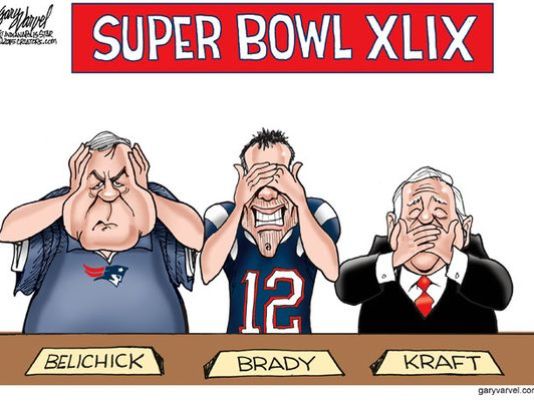
by Adam Hartung | Sep 4, 2015 | Current Affairs, Leadership
Tom Brady’s lawyers convinced a judge this week (9/3/15) to over-rule his four game suspension for using under-inflated footballs in playoff games. This could seem like making a mountain out of a molehill, if it wasn’t so important a statement about bad leadership.
In 1925 golf legend Bobby Jones was playing the U.S. Open when he called a penalty on himself. He claimed that as he moved his club near the ball during his set up he “felt the ball move.” The judges asked the other players if they saw anything which should cause a penalty, and they said no. The judges asked the spectators if they say the ball move, and unanimously everyone said no. So the judges told Mr. Bobby Jones that he need not call a penalty, and he should play on. But Mr. Jones said that he was sure, so he called the penalty on himself.
He lost the U.S. Open by 1 stroke. Had he not called that penalty he would have been in a playoff and may well have won. And that is the kind of thing which creates a legend. Leadership based on honor and ability.
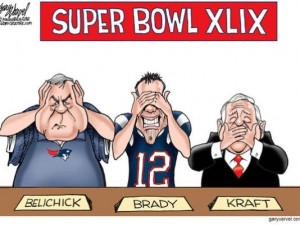 It strains credulity to think Mr. Brady did not know he was playing with under-inflated footballs. This man has won four Superbowls, and been named most valuable player (MVP) 3 times. He is an athlete in the top 1% of professional football players. He touches the football on every play he is in the game, and he has thrown millions of passes in games and practices over his long career. Yet we are to believe he could not feel that these balls were somehow different?
It strains credulity to think Mr. Brady did not know he was playing with under-inflated footballs. This man has won four Superbowls, and been named most valuable player (MVP) 3 times. He is an athlete in the top 1% of professional football players. He touches the football on every play he is in the game, and he has thrown millions of passes in games and practices over his long career. Yet we are to believe he could not feel that these balls were somehow different?
I am a lousy golfer, not nearly good enough to play in amateur, much less professional, tournaments. Yet even I can tell the difference in a golf ball, which I hit with a 3 foot long stick that has a mallet on the end. Professional golfers can talk eloquently about the feel of a golf ball and how it shapes their shots.
Yet we are to believe that Mr. Brady does not have enough sense of feel in his multi-million dollar hands to notice these balls were under-inflated and thereby easier to control? Few professionals believe he did not know.
Tom Brady had his opportunity to call a penalty on himself, and he did not do it. He could have told his coaches, management or officials that the balls felt soft and this should be checked. But his desire to win kept him from pointing out something minor – but something upon which winning or losing could have turned. Then, when he was caught and it was proven he used under-inflated balls, he had the opportunity to say “this was wrong, and I will accept whatever penalty in hopes that this never happens in professional football again.” But instead he refused to accept his penalty and sued the league.
This is NOT the stuff upon which legends are made.
Mr. Brady is a role model for thousands, possibly millions, of football fans and young aspiring athletes. He had the opportunity to show great leadership. Whether Mr. Jones would have won that U.S. Open or not, he forever showed that athletic leaders should never stoop to cheating. No matter how small. Not only by winning golf tournaments did Mr. Jones become a leader, but by his behavior he demonstrated leadership requires honesty, integrity and trust.
As head of the NFL, Mr. Roger Goodell has used this experience to reinforce the better parts of athletic competition. He tried to demonstrate a commitment to athletic leadership and fairness. He did not ban Mr. Brady from the sport, but rather told him he must sit out 4 games for his error in judgement as a leader. This is not unreasonable, and Mr. Goodell gave Mr. Brady an opportunity to demonstrate leadership, and his own commitment to the principles of good leadership.
Mr. Brady could have used this opportunity to help himself, his teammates, his coaches and everyone who watches sports understand the role of a leader. But instead, he chose to argue for the concept of win at any cost. He will forever be remembered as someone who probably cheated, when perhaps cheating was not even necessary to win. And he will be remembered for promoting to millions of fans and followers that winning at any cost – even if you have to go to court – is more important than demonstrating good leadership.
When leaders think they are beyond punishment, bad things happen. Look at Bernie Ebbers of Worldcom, Dennis Koslowski at Tyco and Jeffrey Skilling at Enron. To them winning was all that mattered. They hurt millions of employees, customers, suppliers and investors with such hubris. They were bad leaders, and bad role models. While Mr. Brady will not go to jail, his role in teaching bad leadership principles is fully entrenched – and likely will affect many more future leaders than the worst American business has thus far produced.

by Adam Hartung | Aug 21, 2015 | Current Affairs, Disruptions, Leadership, Transparency
How clearly I remember. I was in the finals of my third grade arithmetic competition. Two of us at the chalkboard, we both scribbled the numbers read to us as fast as we could, did the sum and whirled to look at the judges. Only my competitor was a hair quicker than me, so I was not the winner.
As we walked to the car my mother was quite agitated. “You lost to a GIRL” she said; stringing out that last word like it was some filthy moniker not fit for decent company to here. Born in 1916, to her it was a disgrace that her only son lost a competition to a female.
But it hit me like a tsunami wall. I had underestimated my competitor. And that was stupid of me. I swore I would never again make the mistake of thinking I was better than someone because of my male gender, white skin color, protestant christian upbringing or USA nationality. If I wanted to succeed I had to realize that everyone who competes gets to the end by winning, and they can/will beat me if I don’t do my best.
 This week 1st Lt. Shaye Haver, 25, and Capt. Kristen Griest, 26, graduated Army Ranger training. Maybe the toughest military training in the world. And they were awarded their tabs because they were good – not because they were women.
This week 1st Lt. Shaye Haver, 25, and Capt. Kristen Griest, 26, graduated Army Ranger training. Maybe the toughest military training in the world. And they were awarded their tabs because they were good – not because they were women.
In retrospect, it is somewhat incredible that it took this long for our country to begin training all people at this level. If someone is good, why not let them compete? In what way is it smart to hold back someone from competing based on something as silly as their skin color, gender, religious beliefs or sexual orientation?
Our country, in fact much of mankind, has had a long history of holding people back from competing. Those in power like to stay in power, and will use about any tool they can to maintain the status quo – and keep themselves in charge. They will use private clubs, secret organizations, high investment rates, difficult admission programs, laws and social mores to “keep each to his own kind” as I heard far too often throughout my youth.
As I went to college I never forgot my 3rd grade experience, and I battled like crazy to be at the top of every class. It was clear to me there were a lot of people as smart as I was. If I wanted to move forward, it would be foolish to expect I would rise just because the status quo of the time protected healthy white males. There were plenty of women, people of color, and folks with different religions who wanted the spot I wanted – and they would win that spot. Maybe not that day, but soon enough.
In the 1980s I did a project for The Boston Consulting Group in South Africa. As I moved around that segregated apartheid country it was clear to me that those supporting the status quo did so out of fear. They weren’t superior to the native South Africans. But the only way they could maintain their lifestyle was to prohibit these other people from competing.
And that proved to be untenable. The status quo fell, and when it did many of European extraction quickly fled – unable to compete with those they long kept from competing.
In the last 30 years we’ve coined the term “diversity” for allowing people to compete. I guess that is a nice, politically favorable way to say we must overcome the status quo tools used to hold people back. But the drawback is that those in power can use the term to imply someone is allowed to compete, or even possibly wins, only because they were given “special permission” which implies “special terms.”
That is unfortunate, because most of the time the only break these folks got was being allowed to, finally, compete. Once in the competition they frequently have to deal with lots of attacks – even from their own teammates. Jim Thorpe was a Native American who mesmerized Americans by winning multiple Gold Medals at the 1912 Olympics, and embarrassing the Germans then preaching national/racial superiority as they planned the launch of WW1. But, once back on American soil it didn’t take long for his own countrymen to strip Mr. Thorpe of his medals, unhappy that he was an “Indian” rather than a white man. He tragically died a homeless alcoholic.
And never forget all the grief Jackie Robinson bore as the first African-American professional athlete. Branch Rickey overcame the status quo police by giving Mr. Robinson a chance to play in the all-white professional major league baseball. But Mr. Robinson endured years of verbal and physical abuse in order to continue competing, well over and beyond anything suffered by any of his white peers. (For a taste of the difficulties catch the HBO docudrama “42.”)
In 2014, 4057 highly trained, fit soldiers entered Ranger training. 1,609 (40%) graduated. In this latest class 364 soldiers started; 136 graduated (37%.) Officers Griest and Haver are among the very best, toughest, well trained, well prepared, well armed and smartest soldiers in the entire world. (If you have any doubts about this I encourage you to watch the HBO docudrama “Lone Survivor” about Army Rangers trapped behind enemy lines in Afghanistan.)
Officers Griest and Haver are like every other Ranger. They are not “diverse.” They are good. Every American soldier who recognizes the strength of character and tenacity it took for them to become Rangers will gladly follow their orders into battle. They aren’t women Rangers, they are Rangers.
When all Americans learn the importance of this lesson, and begin to see the world this way, we will allow our best to rise to the top. And our history of finding and creating great leadership will continue.
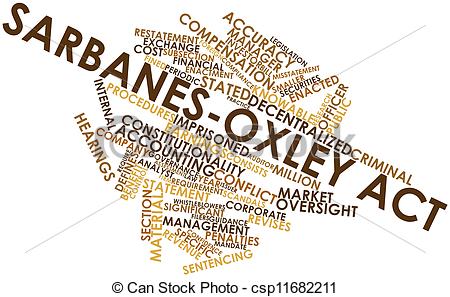
by Adam Hartung | Aug 16, 2015 | Current Affairs, Disruptions, Leadership, Transparency
Last week the National Association of Corporate Directors (NACD) pre-released some results of its 2015–2016 Public Company Governance Survey. One major finding is that the makeup of Boards is changing, for the betterment of investors – and most likely everyone else in business.
Boards once had members that almost never changed. Little was required of Directors, and accountability for Board members was low. Since passage of the Securities Act of 1933, little had been required of Board members other than to applaud management and sign-off on the annual audit. And there was nothing investors could do if a Board “checked out,” even in the face of poorly performing management.
But this has changed. According to NACD, 72% of public boards reported they either added or changed a director in the last year. That is up from 64% in the previous year. Board members, and especially committee chairs, are spending a lot more time governing corporations. As a result “retiring in job” has become nearly impossible, and Board diversity is increasingly quite quickly. And increased Board diversity is considered good for business.
Remember Enron, Arthur Anderson, Worldcom and Tyco? At the century’s turn executives in large companies were working closely with their auditors to undertake risky business propositions yet keep these transactions and practices “off the books.” As these companies increasingly hired their audit firm to also provide business consulting, the auditors found it easier to agree with aggressive accounting interpretations that made company financials look better. Some companies went so far as to lie to investors and regulators about their business, until their companies failed from the risks and unlawful activities.
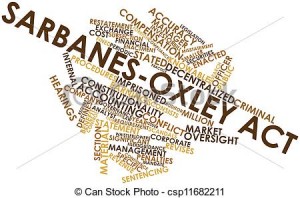 As a result Congress passed the Sarbanes Oxley act in 2002 (SOX,) which greatly increased the duties of Board Directors – as well as penalties if they failed to meet their duties. This law required Boards to implement procedures to unearth off-balance sheet items, and potential illegal activities such as bribing foreign officials or failing to meet industry reporting requirements for health and safety. Boards were required to know what internal controls were in place, and were held accountable for procedures to implement those controls effectively. And they were also required to make sure the auditors were independent, and not influenced by management when undertaking accounting and disclosure reviews. These requirements were backed up by criminal penalties for CEOs and CFOs that fiddled with financial statements or retaliated on whistle blowers – and Boards were expected to put in place systems to discover possibly illegal executive behavior.
As a result Congress passed the Sarbanes Oxley act in 2002 (SOX,) which greatly increased the duties of Board Directors – as well as penalties if they failed to meet their duties. This law required Boards to implement procedures to unearth off-balance sheet items, and potential illegal activities such as bribing foreign officials or failing to meet industry reporting requirements for health and safety. Boards were required to know what internal controls were in place, and were held accountable for procedures to implement those controls effectively. And they were also required to make sure the auditors were independent, and not influenced by management when undertaking accounting and disclosure reviews. These requirements were backed up by criminal penalties for CEOs and CFOs that fiddled with financial statements or retaliated on whistle blowers – and Boards were expected to put in place systems to discover possibly illegal executive behavior.
In short, Sarbanes Oxley increased transparency for investors into the corporation. And it made Boards responsible for compliance. The demands on Board Directors suddenly skyrocketed.
In reaction to the failure of Lehman Brothers and the almost total bank collapse of 2008, Congress passed the Dodd-Frank Wall Street Reform and Consumer Protection Act in 2010. Most of this complex legislation dealt with regulating the financial services industry, and providing more protections for consumers and American taxpayers from risky banking practices. But also included in Dodd-Frank were greater transparency requirements, such as details of executive compensation and how compensation was linked to company performance. Companies had to report such things as the pay ratio of CEO pay to average employee compensation (final rules issued last week,) and had to provide for investors to actually vote on executive compensation (called “say on pay.”) And responsibility for implementing these provisions, across all industries, fell again on the Board of Directors.
Thus, after 13 years of regulatory implementation, we are seeing change in corporate governance. What many laypeople thought was the Board’s job from 1940-2000 is finally, actually becoming their job. Real responsibility is now on the Directors’ shoulders. They are accountable. And they can be held responsible by regulators.
The result is a sea change in how Boards behave, and the beginnings of big change in Board composition. Board members are leaving in record numbers. Unable to simply hang around and collect a check for doing little, more are retiring. The average age is lowering. And diversity is increasing as more women, and people of color as well as non-European family histories are being asked onto Boards. Recognizing the need for stronger Boards to make sure companies comply with regulations they are less inclined to idly stand by and watch management. Instead, Boards are seeking talented people with diverse backgrounds to ask better questions and govern more carefully.
Most business people wax eloquently about the negative effect of regulations. It is easy to find academic studies, and case examples, of the added cost incurred due to higher regulation. But what many people fail to recognize are the benefits. Thanks to SOX and Dodd-Frank companies are far more transparent than ever in history, and transparency is increasing – much to the benefit of investors, suppliers, customers and communities. And corporate governance of everything from accounting to compensation to industry compliance is far more extensive, and better. Because Boards are responsible, they are stronger, more capable and improving at a rate previously unseen – with dramatic improvement in diversity. And we can thank Congress for the legislation which demanded better Board performance – to the betterment of all business.
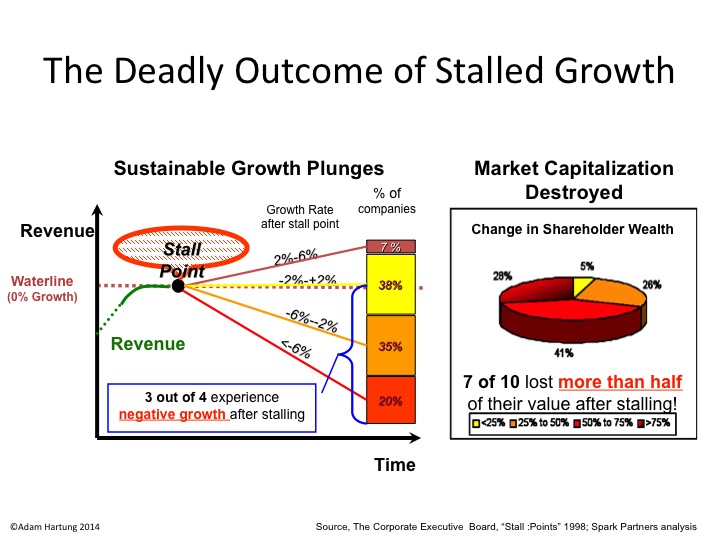
by Adam Hartung | Aug 2, 2015 | Current Affairs, In the Rapids, In the Swamp, Leadership, Web/Tech
eBay was once a game changer. When the internet was very young, and few businesses provided ecommerce, eBay was a pioneer. From humble beginnings selling Pez dispensers, eBay grew into a powerhouse. Things we used to sell via garage sale we could now list on eBay. Small businesses could create stores on eBay to sell goods to customers they otherwise would never reach. And collectors as well as designers suddenly discovered all kinds of products they formerly could not find. eBay sales exploded, as traditional retail started it slide downward.
To augment growth eBay realized those selling needed a simple way to collect money from people who lacked a credit card. Many customers simply had no card, or didn’t trust giving out the information across the web. So eBay bought fledgling PayPal for $1.5B in 2002, in order to grease the wheels for faster ecommerce growth. And it worked marvelously.
But times have surely changed. Now eBay and Paypal have roughly the same revenue. About $8B/year each. eBay has run into stiff competition, as CraigsList has grown to take over the “garage sale” and small local business ecommerce. Simultaneously, powerhouse Amazon has developed its storefront business to a level of sophistication, and ease of use, that makes it viable for businesses from smallest to largest to sell products on-line. And far more companies have learned they can go it alone with internet sales, using search engine optimization (SEO) techniques as well as social media to drive traffic directly to their stores, bypassing storefronts entirely.
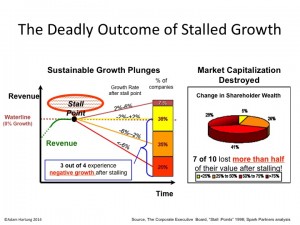 eBay was a game changer, but now is stuck in practices that have become far less relevant. The result has been 2 consecutive quarters of declining revenue. By definition that puts eBay in a growth stall, and fewer than 7% of companies ever recover from a growth stall to consistently increase revenue by a mere 2%/year. Why not? Because once in a growth stall the company has already missed the market shift, and competition is taking customers quickly in new directions. The old leader, like eBay, keeps setting aggressive targets for its business, and tells everyone it will find new customers in remote geographies or vertical markets. But it almost never happens – because the market shift is making their offering obsolete.
eBay was a game changer, but now is stuck in practices that have become far less relevant. The result has been 2 consecutive quarters of declining revenue. By definition that puts eBay in a growth stall, and fewer than 7% of companies ever recover from a growth stall to consistently increase revenue by a mere 2%/year. Why not? Because once in a growth stall the company has already missed the market shift, and competition is taking customers quickly in new directions. The old leader, like eBay, keeps setting aggressive targets for its business, and tells everyone it will find new customers in remote geographies or vertical markets. But it almost never happens – because the market shift is making their offering obsolete.
On the other hand, Paypal has blossomed into a game changer in its own right. Not only does it support cash and credit card transactions for the growing legions of on-line shoppers, but it is providing full payment systems for providers like Uber and AirBnB. It’s tools support enterprise transactions in all currencies, including emerging bitcoin, and even provides international financial transactions as well as working capital for businesses.
Paypal is increasingly becoming a threat to traditional banks. Today most folks use a bank for depositing a pay check, and making payments. There are loans, but frequently that is shopped around irrespective of where you bank. Much like your credit cards, which most people acquire for their benefits rather than a relationship with the issuing bank. If customers increasingly make payments via Paypal, and borrow money via operations like Quicken Loans (a division of Intuit,) why do you need a bank? Discover Services, which now does offer cash deposits and loans on top of credit card services, has found that it can grow substantially by displacing traditional banks.
Paypal is today at the forefront of digital payments processing. It is a fast growing market, which will displace many traditional banks. And emerging competitors like Apple Pay and Google Wallet will surely change the market further – while aiding its growth. How it will shake out is unclear. But it is clear that Paypal is growing its revenue at 60% or greater since 2012, and at over 100%/quarter the last 2 quarters.
Paypal is now valued at about $47B. That is roughly the same as the #5 bank in America (according to assets) Bank of New York Mellon, and number 8 massive credit card issuer Capital One, as well as #9 PNC Bank – and over 50% higher valuation than #10 State Street. It is also about 50% higher than Intuit and Discover. Based on its current market leadership and position as likely game changer for the banking sector, Paypall is selling for about 8 times revenue. If its revenue continues to grow at 100%/quarter, however, revenues will reach over $38B in a year making the Price/Revenue multiple of today only 1.25.
Meanwhile, eBay is valued at about $34B. Given that all which is left in eBay is an outdated on-line ecommerce conglomerator, stuck in a growth stall, that valuation is far harder to justify. It is selling at about 4.25x revenue. But if revenues continue declining, as they have for 2 consecutive quarters, this multiple will expand. And values will be harder and harder to justify as investors rely on hope of a turnaround.
eBay was a game changer. But leadership became complacent, and now it is very likely overvalued. Just as Yahoo became when its value relied on its holdings of Alibaba rather as its organic business shrank. Meanwhile Paypal is the leader in a rapidly growing market that is likely to change the face of not just how we pay, but how we do personal and business finance. There is no doubt which is more valuable today, and likely to be in the future.

by Adam Hartung | Jul 25, 2015 | Current Affairs, In the Whirlpool, Leadership
This week an important event happened on Wall Street. The value of Amazon (~$248B) exceeded the value of Walmart (~$233B.) Given that Walmart is world’s largest retailer, it is pretty amazing that a company launched as an on-line book seller by a former banker only 21 years ago could now exceed what has long been retailing’s juggernaut.
WalMart redefined retail. Prior to Sam Walton’s dynasty retailing was an industry of department stores and independent retailers. Retailing was a lot of small operators, primarily highly regional. Most retailers specialized, and shoppers would visit several stores to obtain things they needed.
But WalMart changed that. Sam Walton had a vision of consolidating products into larger stores, and opening these larger stores in every town across America. He set out to create scale advantages in purchasing everything from goods for resale to materials for store construction. And with those advantages he offered customers lower prices, to lure them away from the small retailers they formerly visited.
And customers were lured. Today there are very few independent retailers. WalMart has ~$488B in annual revenues. That is more than 4 times the size of #2 in USA CostCo, or #1 in France (#3 in world) Carrefour, or #1 in Germany (#4 in world) Schwarz, or #1 in U.K. (#5 in world) Tesco. Walmart directly employes ~.5% of the entire USA population (about 1 in every 200 people work for Walmart.) And it is a given that nobody living in America is unaware of Walmart, and very, very few have never shopped there.
But, Walmart has stopped growing. Since 2011, its revenues have grown unevenly, and on average less than 4%/year. Worse, it’s profits have grown only 1%/year. Walmart generates ~$220,000 revenue/employee, while Costco achieves ~$595,000. Thus its need to keep wages and benefits low, and chronically hammer on suppliers for lower prices as it strives to improve margins.
 And worse, the market is shifting away from WalMart’s huge, plentiful stores toward on-line shopping. And this could have devastating consequences for WalMart, due to what economists call “marginal economics.”
And worse, the market is shifting away from WalMart’s huge, plentiful stores toward on-line shopping. And this could have devastating consequences for WalMart, due to what economists call “marginal economics.”
As a retailer, Walmart spends 75 cents out of every $1 revenue on the stuff it sells (cost of goods sold.) That leaves it a gross margin of 25 cents – or 25%. But, all those stores, distribution centers and trucks create a huge fixed cost, representing 20% of revenue. Thus, the net profit margin before taxes is a mere 5% (Walmart today makes about 5 cents on every $1 revenue.)
But, as sales go from brick-and-mortar to on-line, this threatens that revenue base. At Sears, for example, revenues per store have been declining for over 4 years. Suppose that starts to happen at Walmart; a slow decline in revenues. If revenues drop by 10% then every $100 of revenue shrinks to $90. And the gross margin (25%) declines to $22.50. But those pesky store costs remain stubbornly fixed at $20. Now profits to $2.50 – a 50% decline from what they were before.
A relatively small decline in revenue (10%) has a 5x impact on the bottom line (50% decline.) The “marginal revenue”, is that last 10%. What the company achieves “on the margin.” It has enormous impact on profits. And now you know why retailers are open 7 days a week, and 18 to 24 hours per day. They all desperately want those last few “marginal revenues” because they are what makes – or breaks – their profitability.
All those scale advantages Sam Walton created go into reverse if revenues decline. Now the big centralized purchasing, the huge distribution centers, and all those big stores suddenly become a cost Walmart cannot avoid. Without growing revenues, Walmart, like has happened at Sears, could go into a terrible profit tailspin.
And that is what Amazon is trying to do. Amazon is changing the way Americans shop. From stores to on-line. And the key to understanding why this is deadly to Walmart and other big traditional retailers is understanding that all Amazon (and its brethren on line) need to do is chip away at a few percentage points of the market. They don’t have to obtain half of retail. By stealing just 5-10% they put many retailers, they ones who are weak, right out of business. Like Radio Shack and Circuit City. And they suck the profits out of others like Sears and Best Buy. And they pose a serious threat to WalMart.
And Amazon is succeeding. It has grown at almost 30%/year since 2010. That growth has not been due to market growth, it has been created by stealing sales from traditional retailers. And Amazon achieves $621,000 revenue per employee, while having a far less fixed cost footprint.
What the marketplace looks for is that point at which the shift to on-line is dramatic enough, when on-line retailers have enough share, that suddenly the fixed cost heavy traditional retail business model is no longer supportable. When brick-and-mortar retailers lose just enough share that their profits start the big slide backward toward losses. Simultaneously, the profits of on-line retailers will start to gain significant upward momentum.
And this week, the marketplace started saying that time could be quite near. Amazon had a small profit, surprising many analysts. It’s revenues are now almost as big as Costco, Tesco – and bigger than Target and Home Depot. If it’s pace of growth continues, then the value which was once captured in Walmart stock will shift, along with the marketplace, to Amazon.
In May, 2010 Apple’s value eclipsed Microsoft. Five years later, Apple is now worth double Microsoft – even though its earnings multiple (stock Price/Earnings) is only half (AAPL P/E = 14.4, MSFT = 31.) And Apple’s revenues are double Microsoft’s. And Apple’s revenues/employee are $2.4million, 3 times Microsoft’s $731k.
While Microsoft has about doubled in value since the valuation pinnacle transferred to Apple, investors would have done better holding Apple stock as it has more than tripled. And, again, if the multiple equalizes between the companies (Apple’s goes up, or Microsoft’s goes down,) Apple investors will be 6 times better off than Microsoft’s.
Market shifts are a bit like earthquakes. Lots of pressure builds up over a long time. There are small tremors, but for the most part nobody notices much change. The land may actually have risen or fallen a few feet, but it is not noticeable due to small changes over a long time. But then, things pop. And the world quickly changes.
This week investors started telling us that the time for big change could be happening very soon in retail. And if it does, Walmart’s size will be more of a disadvantage than benefit.

 But, if you were surprised, you should not have been. The telltale signs that this was going to happen have been there for years. Like most stock market moves, this one just happened really fast. The “herd behavior” of investors means that most people don’t move until some event happens, and then everyone moves at once carrying out the implications of a sea change in thinking about a company’s future.
But, if you were surprised, you should not have been. The telltale signs that this was going to happen have been there for years. Like most stock market moves, this one just happened really fast. The “herd behavior” of investors means that most people don’t move until some event happens, and then everyone moves at once carrying out the implications of a sea change in thinking about a company’s future.















